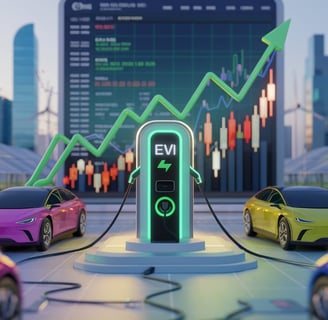"This EV Stock is Charging Ahead: 50% Revenue Guidance from EV Charger Business – A Game-Changer for Investors!"
"Discover the EV stock revolutionizing the market with a bold 50% revenue projection from its EV charger business. Dive into its innovative strategies, financial growth potential, and role in driving the future of sustainable transportation."
evnovatech.com
12/16/20244 min read


"This EV Stock is Charging Ahead: 50% Revenue Guidance from EV Charger Business – A Game-Changer for Investors!"
Introduction: The EV Revolution and the Role of EV Chargers
Electric vehicles (EVs) are no longer the future—they’re the present. With global EV adoption soaring, the backbone of this revolution lies in the infrastructure: EV chargers. One EV stock is making waves by projecting a jaw-dropping 50% of its revenue from its EV charger business. This isn’t just another EV story; it’s a pivotal shift in how we view opportunities within the EV ecosystem.
In this article, we’ll delve into why this stock deserves your attention, explore the company’s strategic positioning, and break down how its EV charger business is transforming the market. Whether you’re a seasoned investor or a curious observer, this story is one you’ll want to follow closely.
Step 1: The Explosive Growth of EVs and the Infrastructure Demand
The EV market is experiencing unparalleled growth, with global sales expected to surpass 14 million units in 2024, representing a significant leap from just a few years ago. While sleek car designs and groundbreaking battery technologies dominate headlines, a less glamorous—but equally crucial—sector is quietly booming: EV charging infrastructure.
For every EV on the road, reliable charging stations are essential. The International Energy Agency (IEA) estimates that the world will need 30 million public EV chargers by 2030 to support the growing fleet. This unmet demand is creating a gold rush for companies in the EV charging sector.
Step 2: The Stock Leading the EV Charger Revolution
While Tesla, Rivian, and Lucid often steal the spotlight, one lesser-known company is making a strategic pivot that could redefine its future. This stock (let’s call it Company X for now) has diversified its portfolio to focus heavily on EV chargers, aiming for them to account for 50% of total revenue within the next five years.
Who is Company X?
Company X is a mid-cap EV manufacturer that identified early on the rising need for infrastructure. While its EV models have gained moderate traction, the company’s real genius lies in its EV charger business. By leveraging existing partnerships with municipalities, private enterprises, and utility providers, Company X is rapidly scaling its charging network.
Step 3: Why the 50% Revenue Guidance Matters
A 50% revenue contribution from EV chargers is a bold projection, signaling a paradigm shift. Traditionally, EV manufacturers rely on car sales as their primary revenue stream. Diversifying into EV charging allows Company X to:
Create Recurring Revenue Streams:
Unlike one-time vehicle sales, EV charging generates consistent revenue through usage fees, subscriptions, and maintenance contracts.Capitalize on Government Incentives:
Governments worldwide are pouring billions into EV infrastructure. From the U.S. Infrastructure Investment and Jobs Act to Europe’s Green Deal, grants and subsidies are up for grabs. Company X is strategically positioning itself to benefit from these funds.Differentiate Itself from Competitors:
In a crowded EV market, focusing on chargers gives Company X a unique edge. They’re not just selling vehicles; they’re selling the entire ecosystem.
Step 4: Breaking Down the Business Model
Company X’s EV charger business operates on a multifaceted model:
Public Charging Networks:
Company X has partnered with city governments to install fast-charging stations in urban hubs. These chargers are designed to reduce “range anxiety” for city dwellers.Residential Chargers:
Catering to homeowners, the company offers easy-to-install residential chargers, complete with app-based controls.Fleet Solutions:
With the rise of EV fleets for delivery services and ride-sharing, Company X has tapped into a lucrative B2B segment, offering bulk solutions tailored for commercial needs.
Each segment contributes to a robust and diversified revenue stream, ensuring stability and growth.
Step 5: Financial Metrics to Watch
When evaluating the stock, keep an eye on these key performance indicators:
Charger Installations:
Track the number of chargers installed annually. Growth here directly correlates with future revenue potential.Utilization Rates:
High utilization rates signal strong demand and efficient placement of charging stations.Revenue Mix:
As EV chargers approach 50% of total revenue, expect to see higher gross margins compared to vehicle sales.Market Share in Key Regions:
Company X is aggressively expanding in North America and Europe, two of the fastest-growing EV markets.
Step 6: Challenges to Consider
No investment is without risks, and Company X is no exception. Potential challenges include:
Competition:
Established players like Tesla (Supercharger Network) and ChargePoint have a head start.High Initial Costs:
Building charging infrastructure requires significant upfront investment.Regulatory Hurdles:
Local permitting processes and zoning laws can slow down charger deployment.
Despite these challenges, Company X’s innovative approach and strong partnerships position it well to navigate obstacles.
Step 7: Real-World Impact and What It Means for You
Think about this: by 2030, almost every parking lot, highway rest stop, and residential building could have EV chargers. Investing in Company X isn’t just about profits; it’s about being part of a sustainable future. For retail investors, this represents an opportunity to back a company driving tangible change while reaping financial rewards.
FAQs
Q1: Why is the EV charger business so critical now?
The EV charger business is critical because the success of EV adoption hinges on accessible and reliable charging infrastructure. Without it, range anxiety and logistical challenges could slow down the EV revolution.
Q2: How does Company X compare to Tesla or ChargePoint?
While Tesla focuses on its proprietary network, and ChargePoint emphasizes B2B solutions, Company X strikes a balance by catering to both public and private markets with a diversified portfolio.
Q3: What’s the biggest risk in investing in EV charger stocks?
The biggest risks include high capital expenditure requirements, competitive pressures, and regulatory delays in installing chargers.
Q4: Are there government incentives for EV charger companies?
Yes, governments globally are incentivizing EV infrastructure through grants, subsidies, and tax breaks. This creates a favorable environment for companies like Company X.
Q5: How can I invest in this stock?
The stock is publicly traded on [Stock Exchange]. Make sure to consult a financial advisor to understand how it fits into your portfolio.
Conclusion: A Stock Worth Watching
The EV industry is more than just cars; it’s an ecosystem where infrastructure plays a pivotal role. With its bold 50% revenue guidance from EV chargers, Company X is positioning itself as a leader not just in EV manufacturing but in powering the future of transportation.
